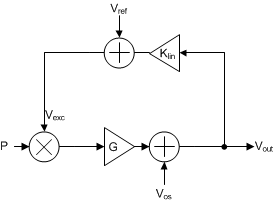SBOS936E November 2019 – August 2022 OPA182 , OPA2182 , OPA4182
PRODMIX
- 1 Features
- 2 Applications
- 3 Description
- 4 Revision History
- 5 Device Comparison Table
- 6 Pin Configuration and Functions
- 7 Specifications
- 8 Detailed Description
- 9 Application and Implementation
- 10Device and Documentation Support
- 11Mechanical, Packaging, and Orderable Information
Package Options
Mechanical Data (Package|Pins)
Thermal pad, mechanical data (Package|Pins)
Orderable Information
9.2.1.2 Detailed Design Procedure
The bridge sensor signal flow model is shown in Figure 9-2.
 Figure 9-2 Bridge Sensor Signal Flow Model
Figure 9-2 Bridge Sensor Signal Flow ModelThe bridge sensor is modeled as a multiplier, with inputs from an excitation voltage and pressure sensor producing an output voltage given in Equation 1:

Kp is the sensitivity of the bridge sensor, and is usually specified in mV/V. P represents the pressure relative to the range of the sensor, normalized to a scale from 0 to 1. Solving this equation with the variables given in the signal flow model and solving for Vout results in Equation 2:

This equation has three variables, VOS, G and Klin, that require three equations to solve. To solve these equations. values of Kp at no load, midscale and full load conditions are needed for the sensor. With these values, the system can be linearized.
With known values for Kp, Klin is calculated as shown in Equation 3:

In this equation, Bv represents the bridge nonlinearity, which is calculated as shown in Equation 4:

Bv is solved based on the sensor specifications, and the equation is then used to solve for Klin. Next, the system gain is calculated using Equation 5 and Equation 6.


Solving for VOS in both equations and combining results in Equation 7.

Solving for G gives Equation 8.

With both Klin and G now calculated, VOS is solved as shown in Equation 9.

For a sensor with a KP of 0.0003 mV/V at no load, 0.0017 mV/V midscale and 0.00289 mV/V, the corresponding nonlinearity is approximately 4%. Solving for Klin, G, and VOS gives the values shown in Table 9-1.
| Klin | 0.173913 |
|---|---|
| G | 323.8178 |
| VOS | -0.48573 |